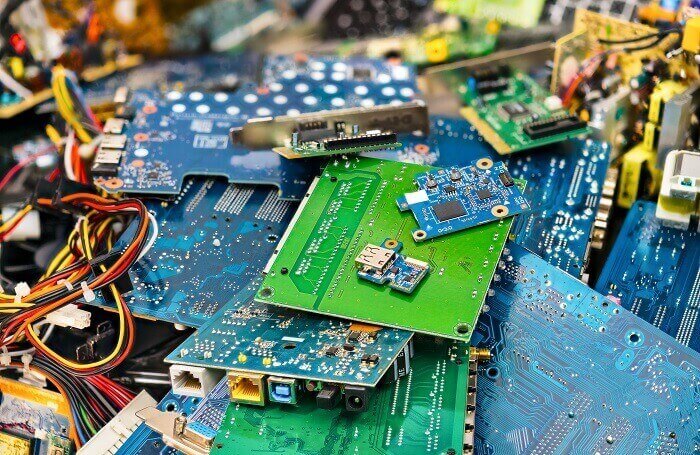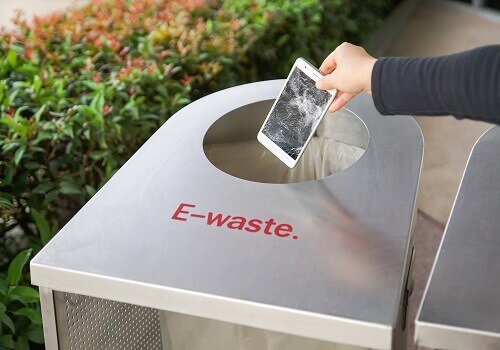
You probably have old computer monitors, TVs, printers, cables, circuit boards, DVD players, clocks, flashlights, CD players, and radios at home you want to get rid of. They are collectively called electronic waste or e-waste.
Electronic wastes are usually found in the basement and storage rooms at home for many years and people don’t know what to do with them. Sometimes these materials can be used for DIY crafts and parts alternative.
However, how do you dispose of these items without harming the environment? Read this short guide about proper electronic waste disposal to learn more.
Don’t Throw Away Electronic Waste In Garbage Bins
Business and consumer electronic equipment or anything that contains chips or circuit boards or you plug into an electrical outlet is e-waste.
These products tend to have heavy metals such as lead, cadmium, chromium, and copper. Throwing them in garbage bins could contaminate the environment and harm public health.

It’s best to bring your e-waste to dedicated receiving areas for e-waste in your municipal or city waste management services.
In addition, you can contact a private waste removal professional to get rid of your e-waste following the right protocols. Check out Same-Day Rubbish Removal and other rubbish removal companies for professional and stress-free electronic waste disposal.
Participate In Electronic Exchanges
You can send back electronic items to the manufacturer or electronic companies with an exchange policy. When you purchase a new one from the same company, you can exchange your old electronic gadgets to get a discount.
In addition, some electronic companies have recycling drop off areas where you can drop your obsolete and unused keyboards, computer monitors, phones, tablets, and other electronic items.
Sell Or Donate Them
Did you know you could make money with your obsolete electronic devices? Yes, you just need to bring your e-waste to your local electronic shops and sell them for extra bucks.
You can hold a garage sale and sell your old appliances like air conditioner, fridge, and washing machine. DIYers and repair people passing by might be interested in buying them. Also, you can sell them online in major marketplaces.
Know The E-Waste Trends
It’s important to know the latest trends in electronic waste to be more aware of how much e-waste you produce and eliminate later on.
For instance, electronic face masks are now available, claiming to be more effective in fighting COVID-19 and air pollution. They are rechargeable via Li-Po batteries that charge via USB cables. But how can you dispose of electronic face masks later on?
It’s crucial to be aware of how you generate and dispose of e-waste as a responsible citizen. Before buying any new e-product, make sure to know the steps you need to do when they have come to their end of useful life.
One way is to ask a question directly to the seller or manufacturer if they have any recycling drop-off point or recovery policy.
Recycle
According to a statistical report, the amounts of electronic waste the world generates exceed 50 million tons in 2020, with 4% to 5% annual growth. Despite e-waste having high-value recoverable materials like copper and gold, there are only 20% of electronic waste being recycled.
In addition, recycling or reusing computers can create more jobs every year for tons of computer waste processed every year than disposing of them in landfills.
If you have old phones, you can reuse working ones or recycle them. You can search for an e-waste recycling center in your local area to recycle your e-waste. Store your e-waste and send it to the recycling center.
Generally, here’s how the e-waste recycling process works:
- Collection: The electronic waste recycling process starts collection through waste pickers or exchange or ‘take back’ programs.
- Toxic Removal: After the e-waste reaches the recycling center, the next step is removing dangerous components and separating them into different groups depending on the material. This can be done manually (using hammers, screwdrivers, and labeled containers), mechanically (using magnets, giant shredders, and conveyor belts), or both.
- Recovery Of Secondary Materials: Some examples of secondary materials that can be recovered from e-waste include silver, gold, copper, and high-value materials such as neodymium, dysprosium, and terbium.
Conclusion
Proper e-waste disposal takes a matter of knowing the best way and places to dispose of old electronic products.
You can reuse or recycle them or hand them to waste management professionals to get rid of them the right way without harming health and causing pollution.
By keeping yourself abreast of proper e-waste disposal, you can even make money by selling them and protect the environment.










